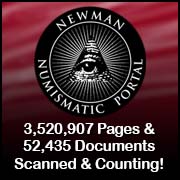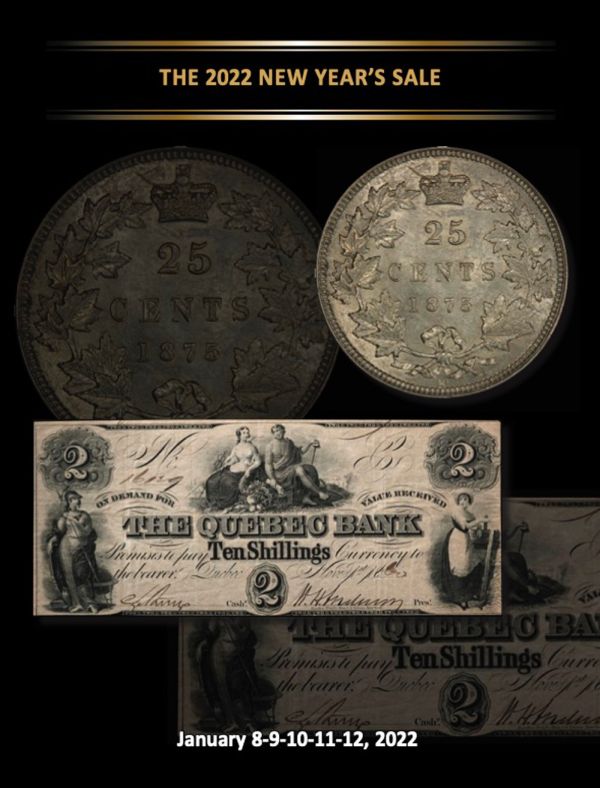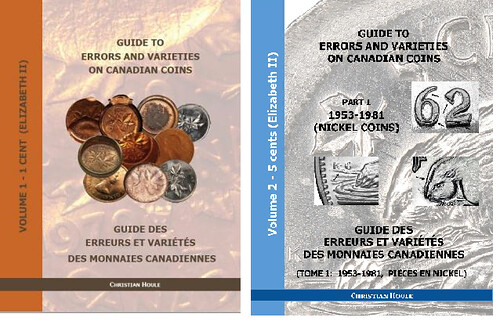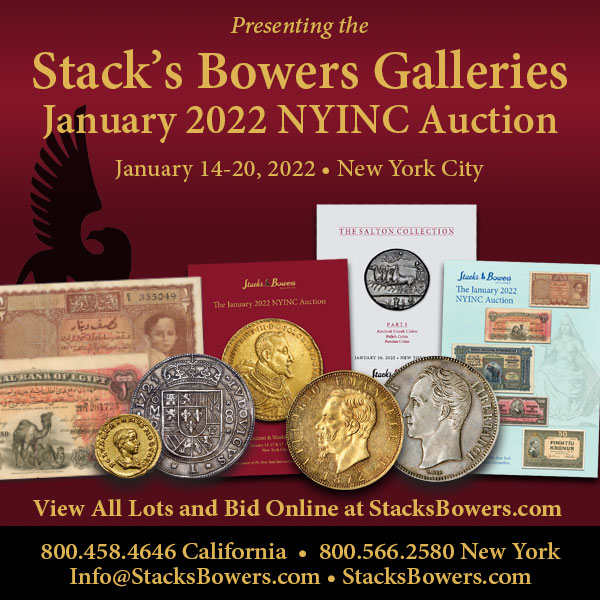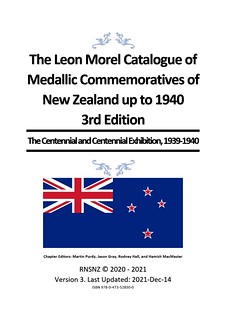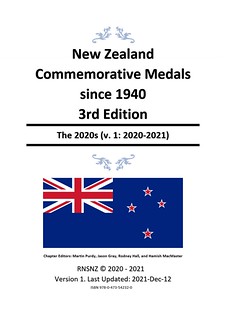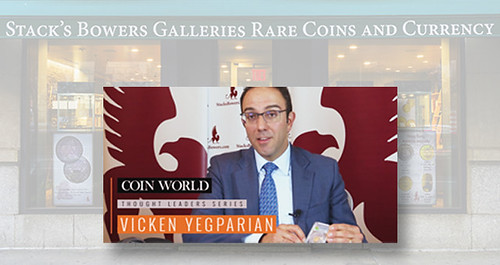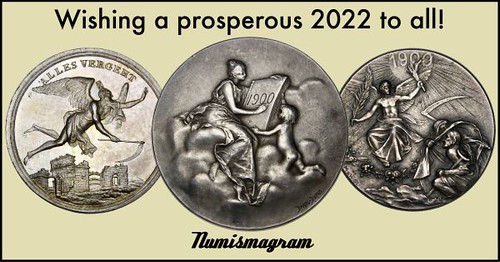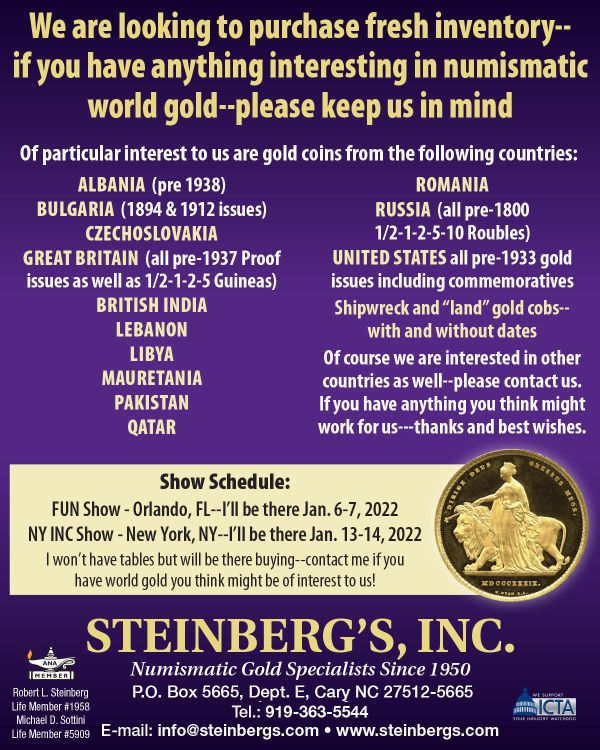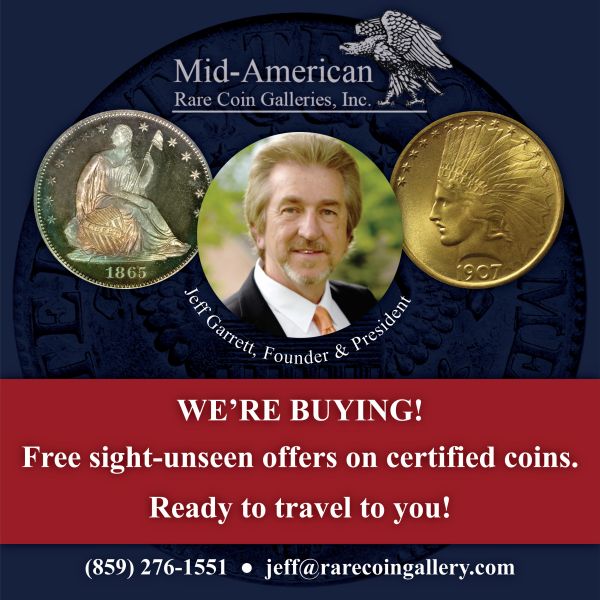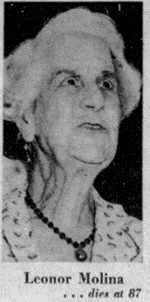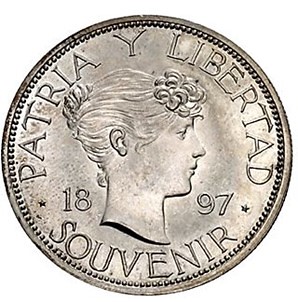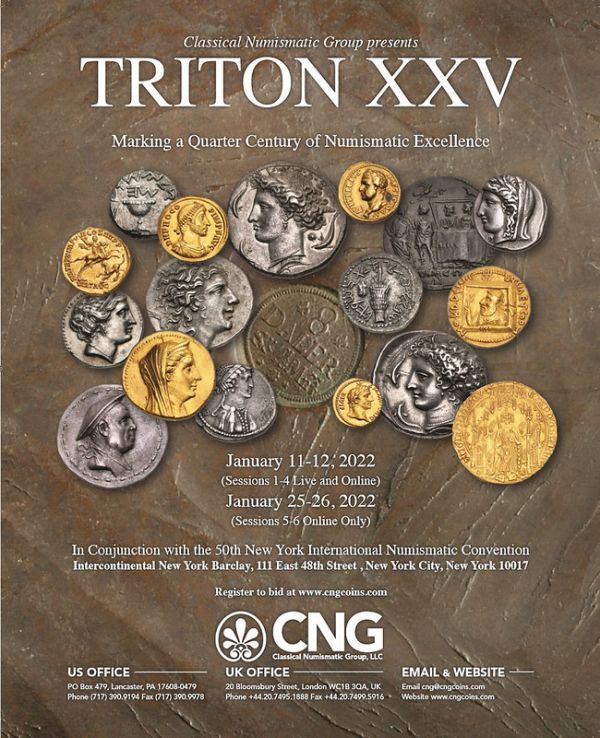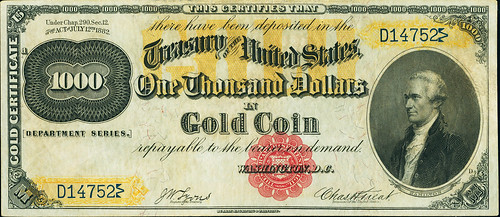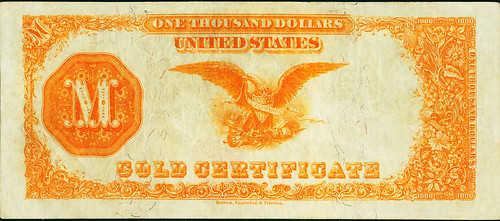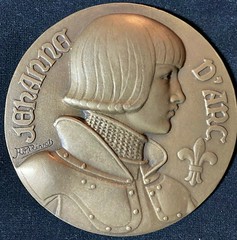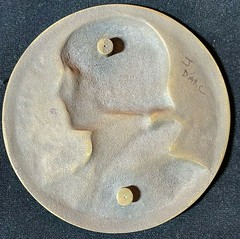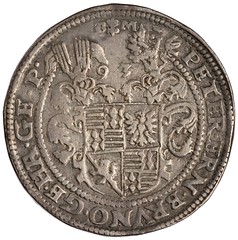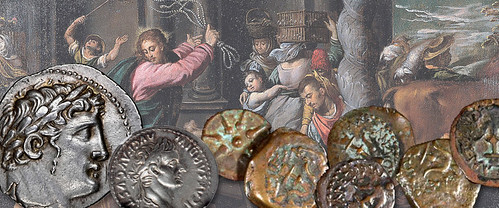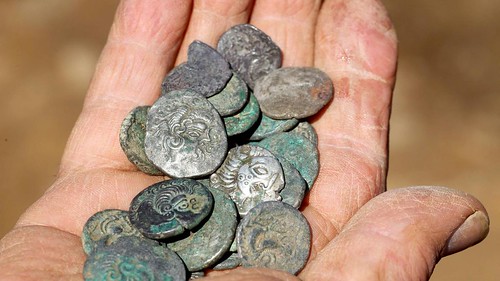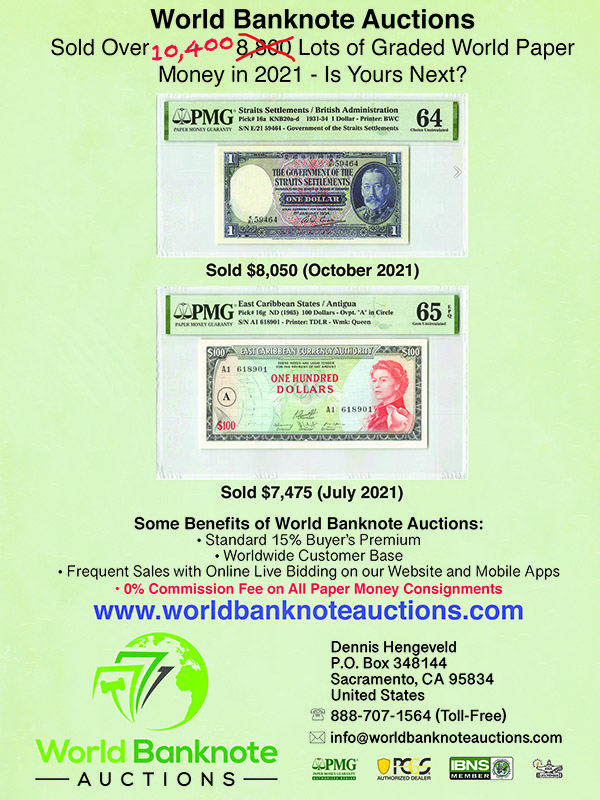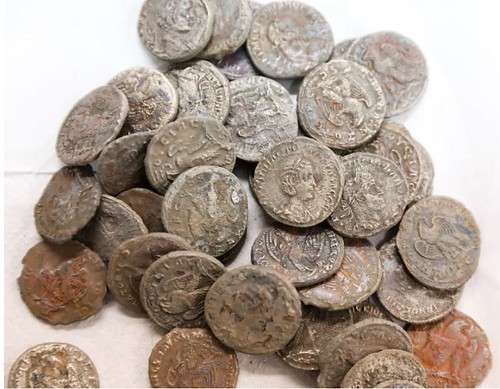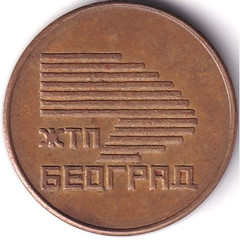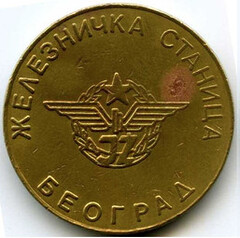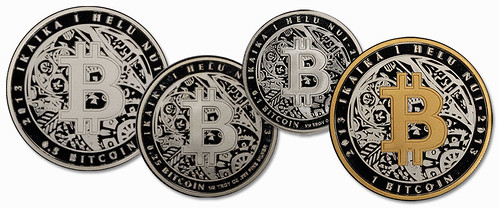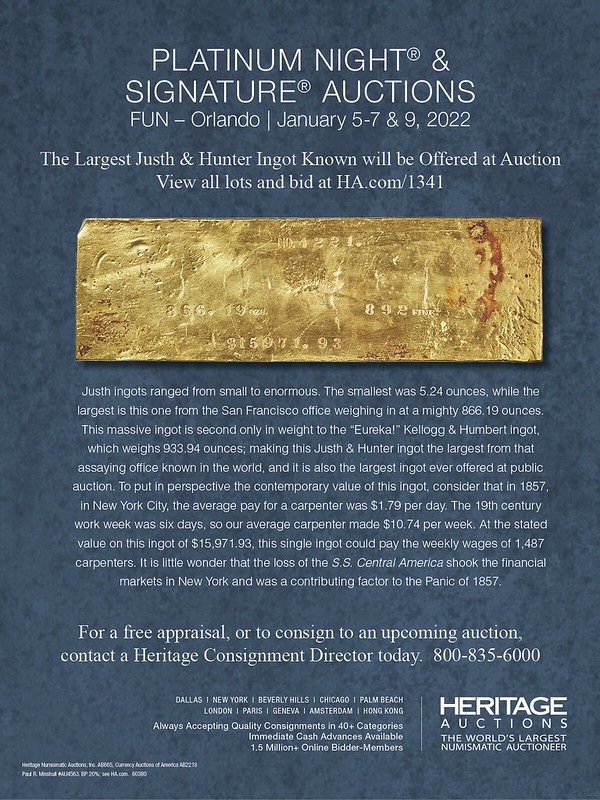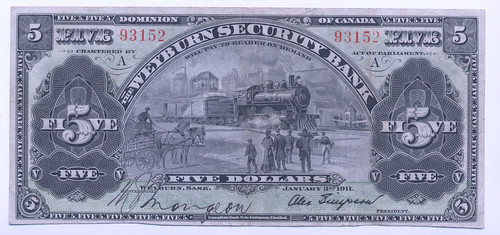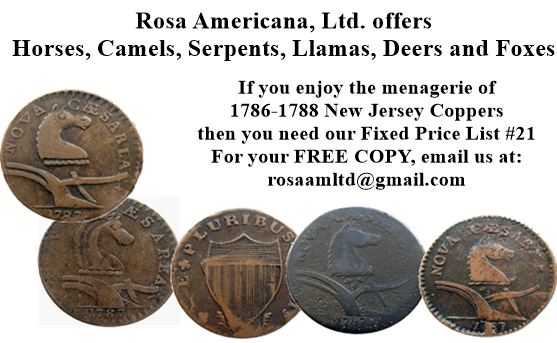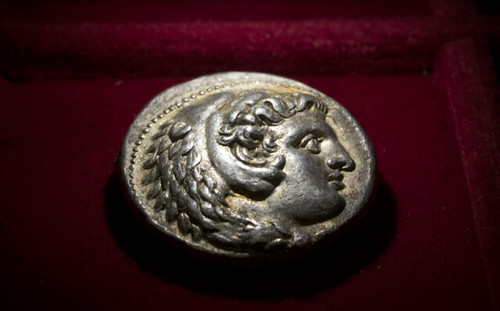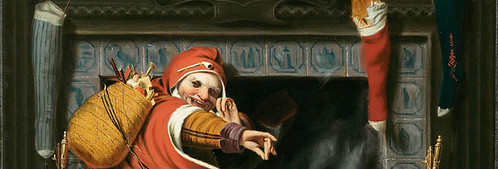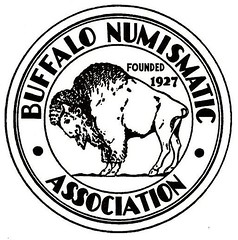
Visit our NBS Sponsors


About UsThe Numismatic Bibliomania Society is a non-profit association devoted to the study and enjoyment of numismatic literature. For more information please see our web site at coinbooks.org SubscriptionsThose wishing to become new E-Sylum subscribers (or wishing to Unsubscribe) can go to the following web page link MembershipThere is a membership application available on the web site Membership Application To join, print the application and return it with your check to the address printed on the application. Print/Digital membership is $40 to addresses in the U.S., and $60 elsewhere. A digital-only membership is available for $25. For those without web access, write to: Charles Heck, Treasurer AsylumFor Asylum mailing address changes and other membership questions, contact Chuck at this email address: treasurer@coinbooks.org SubmissionsTo submit items for publication in The E-Sylum, write to the Editor at this address: whomren@gmail.com BUY THE BOOK BEFORE THE COINSale CalendarWatch here for updates! |
- WAYNE'S WORDS: THE E-SYLUM DECEMBER 26, 2021
- NEW BOOK: ERRORS ON CANADIAN COINS, V2
- NEW BOOK: SOUTH AFRICA TOKENS
- NEW CHAPTERS: NEW ZEALAND MEDALS 1939-40, 2020S
- 2021 ANS LIBRARY & ARCHIVES ACQUISITIONS
- VICKEN YEGPARIAN COIN WORLD COLUMN DEBUTS
- KOENINGS' REEDED EDGE HALF NEWSLETTER
- VIDEO: COINS IN THE BIBLE
- FIRST U.S. NUMISMATIC SOCIETY?
- POTENTIAL A.N.A. 75-YEAR MEMBERS
- NOTES FROM E-SYLUM READERS: DECEMBER 26, 2021
- COIN FOUND IN LEE STATUE TIME CAPSULE
- VOCABULARY TERM: BUFFING AND POLISHING
- LEE F. HEWITT (1911-1987)
- REMEMBERING ROBERT LLOYD
- LEONOR MOLINA (1869-1957)
- THE FUTURE OF LIVE AUCTIONS
- HERITAGE 2022 FUN SALE PAPER MONEY HIGHLIGHTS
- WEXFORD EBAY MEDAL SELECTIONS DECEMBER 2021
- NUMISMATIC NUGGETS: DECEMBER 26, 2021
- SOURCES OF ROMAN SILVER COINAGE
- THE COINS OF CHRIST
- JERSEY COIN HOARD SOLD
- ISRAELI ARCHAEOLOGISTS EXPLORE SHIPWRECK SITE
- PLATFORM TICKETS
- LEALANA BITCOIN SET OFFERED
- JUDAICA ART MEDAL AWARDS ANNOUNCED
- WEYBURN SECURITY BANK NOTES
- THE IMPORTANCE OF NUMISMATICS
- WHICH CAME FIRST: DEBT OR MONEY?
- NEW BOOK: THE PRIVATE LIBRARY
- LOOSE CHANGE: DECEMBER 26, 2021
- FEATURED WEB SITE: BUFFALO NUMISMATIC ASSOCIATION
Click here to read the thin version on the web
Click here to subscribe
Click here to access the complete archive
To comment or submit articles, reply to whomren@gmail.com
Content presented in The E-Sylum is not necessarily researched or independently fact-checked, and views expressed do not necessarily represent those of the Numismatic Bibliomania Society.
WAYNE'S WORDS: THE E-SYLUM DECEMBER 26, 2021
 New subscribers this week include:
Arlene Goromboly courtesy O.T. Thompson;
and
Steve Moulding.
Welcome aboard! We now have 6,748 subscribers.
New subscribers this week include:
Arlene Goromboly courtesy O.T. Thompson;
and
Steve Moulding.
Welcome aboard! We now have 6,748 subscribers.
Thank you for reading The E-Sylum. If you enjoy it, please send me the email addresses of friends you think may enjoy it as well and I'll send them a subscription. Contact me at whomren@gmail.com anytime regarding your subscription, or questions, comments or suggestions about our content.
This week we open with three new books, ANS Library and Archives acquisitions, a new Coin World column, updates from the Newman Numismatic Portal, and more.
Other topics this week include the first U.S. numismatic society, notes from readers, Lee Hewitt, Leonor Molina, Gail Brichford, the future of live auctions, auction highlights, the coins of Christ, ancient coin hoards, platform tickets, Lealana physical bitcoins, Judaica art medals, and the Buffalo Numismatic Association.
To learn more about errors on Canadian coins, South Africa tokens, scanning for the Newman Numismatic Portal, Russian numismatic books, Reeded Edge Half Dollars, what to call a certified coin, Robert E. Lee statue time capsule, buffing and polishing, the model for the Cuba Peso coins of 1897 and 1898, Joan of Arc, the origin of silver used in Roman coinage, Platform 9-3/4, and Hoppy's experiments, read on. Have a great week, everyone!
Wayne Homren
Editor, The E-Sylum
NEW BOOK: ERRORS ON CANADIAN COINS, V2
The second in a series of books on Canadian error coins of the Elizabeth II era has been published. The new volume covers errors on five cent coins. -Editor
GUIDE TO ERRORS AND VARIETIES ON CANADIAN COINS
NEW BOOK: SOUTH AFRICA TOKENS
Yosef Sa'ar passed along this new book on the tokens of South Africa. Thanks! -Editor
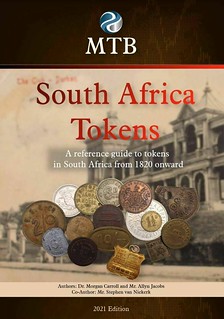 New Token Catalog of South Africa 2021
New Token Catalog of South Africa 2021
South Africa Token Catalog 1820 onward - 2021 edition
Condition: Brand new
Price: AU $139.00
A newly printed catalog on Tokens of South Africa (printed Dec 2021)
The Catalog contains:

NEW CHAPTERS: NEW ZEALAND MEDALS 1939-40, 2020S
Two new digital chapters have been released in the progressive update to Leon Morel's catalogue of NZ Commemorative Medals prior to 1940. Thanks to Martin Purdy of Upper Hutt, New Zealand for passing this information along. -Editor
This is part of a projected multi-volume series updating Leon Morel's Catalogue of Medallic Commemoratives of New Zealand, 1865-1940 (1996) and the Supplement published in 2000. The third edition marks a departure from previous RNSNZ catalogue projects in that it is being released electronically in the first instance, and in sections. In this way, parts of the book can be published as they become ready, and can also be regularly updated as new information becomes available.

2021 ANS LIBRARY & ARCHIVES ACQUISITIONS
In the 2021 Annual Report of the American Numismatic Society, there's a nicely illustrated article about the ANS Library & Archives. With permission, we're republishing it here. Thank you! -Editor
We are finally able to welcome our members back to the ANS Library!
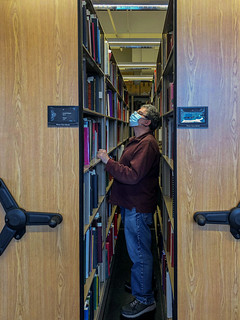 We are excited to finally welcome our members and other visitors back in person as we once again open our library collections for onsite research. Not that we've been closed for the past year. We've been here the whole time, connecting with members, helping people remotely, acquiring and cataloging the latest books, filling holes in our collection with carefully selected older works, processing archival records and rare items given to us by generous donors, and much more. We also have our donors to thank for financial support, with funding coming from individuals like Mark Tomasko, David Tripp, William Burd, Michael Bates, and Paul Harris, as well as from the Eric P. Newman Numismatic Education Society.
We are excited to finally welcome our members and other visitors back in person as we once again open our library collections for onsite research. Not that we've been closed for the past year. We've been here the whole time, connecting with members, helping people remotely, acquiring and cataloging the latest books, filling holes in our collection with carefully selected older works, processing archival records and rare items given to us by generous donors, and much more. We also have our donors to thank for financial support, with funding coming from individuals like Mark Tomasko, David Tripp, William Burd, Michael Bates, and Paul Harris, as well as from the Eric P. Newman Numismatic Education Society.
Image: ANS Fellow Constantin Marinescu visiting the library

VICKEN YEGPARIAN COIN WORLD COLUMN DEBUTS
In an article published December 17, 2021, Coin World announced a new column by Vicken Yegparian of Stack's Bowers. With permission, we're republishing it here. We'll look forward to seeing the column. -Editor
A new column,The Auctioneer's Dispatch
by professional numismatist Vicken Yegparian, debuted in the January 2022 issue and will also appear weekly in Coin World.

KOENINGS' REEDED EDGE HALF NEWSLETTER
The latest addition to the Newman Numismatic Portal is Koenings' Reeded Edge Half Newsletter. Project Coordinator Len Augsburger provided the following report. -Editor
Koenings' Reeded Edge Half Newsletter
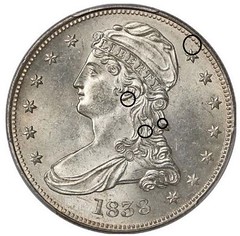 In 2012 Dick Graham published A Registry of Die Varieties of Reeded Edge Half Dollars, presenting a die variety analysis of the U.S. half dollars struck from 1836 to 1839. The work extended the well-known Overton guide, which covered the Flowing Hair and Bust half dollars from 1794-1836. Graham identified 56 die marriage for the short series.
In 2012 Dick Graham published A Registry of Die Varieties of Reeded Edge Half Dollars, presenting a die variety analysis of the U.S. half dollars struck from 1836 to 1839. The work extended the well-known Overton guide, which covered the Flowing Hair and Bust half dollars from 1794-1836. Graham identified 56 die marriage for the short series.
More recently, Jim Koenings has used Graham's work as a starting point and has been doing in depth analysis of individual Graham numbers on a monthly basis. The most recently installment, #32 for December 2021, covers the 1838 GR-9 variety. Collectors of the series will find this supplemental material most useful – Koenings includes additional images and hints for attributions and die states, in addition to data on recent sales and related market activity.
Image: 1838 GR-9, PCGS MS64+ CAC, image courtesy of Heritage Auctions
Link to Koenings' Reeded Edge Half Newsletter on Newman Portal:
https://nnp.wustl.edu/library/publisherdetail/540192
VIDEO: COINS IN THE BIBLE
These are selections from the David Lisot Video Library that feature news and personalities from the world of coin collecting. David has been attending coin conventions since 1972 and began videotaping in 1985. The Newman Numismatic Portal now lists all David's videos on their website at:
https://nnp.wustl.edu/library/multimediadetail/522852
Here's one on Coins in the Bible with Mike Markowitz of the Ancient Numismatic Society of Washington. -Editor
Coins in the Bible
VIDEO: 44.26.
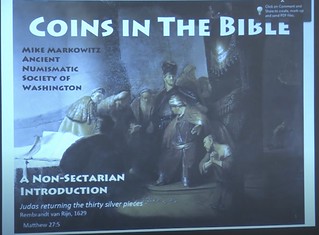 The Bible gives reference to many coins in both the Old and New Testaments. Learn the passages and coins that are mentioned from Michael Markowitz, well known speaker and numismatic researcher. You will learn about the shekel of Tyre, thought by scholars to have been paid to Judas for the betrayal of Christ. Find out what coin was thought to have been shown to Jesus when he said, "render unto Caesar what is Caesar's". Plus you will learn about other ancient coins most of which are available to collectors today. This presentation was made at the Whitman Expo in Baltimore in 2013.
The Bible gives reference to many coins in both the Old and New Testaments. Learn the passages and coins that are mentioned from Michael Markowitz, well known speaker and numismatic researcher. You will learn about the shekel of Tyre, thought by scholars to have been paid to Judas for the betrayal of Christ. Find out what coin was thought to have been shown to Jesus when he said, "render unto Caesar what is Caesar's". Plus you will learn about other ancient coins most of which are available to collectors today. This presentation was made at the Whitman Expo in Baltimore in 2013.
The video is available for viewing at:
https://nnp.wustl.edu/library/book/545043

FIRST U.S. NUMISMATIC SOCIETY?
American Numismatic Society Librarian David Hill and Joel Orosz authored a new ANS Pocket Change article about an obscure organization that may well have been the first numismatic association in the United States. -Editor
A couple of months ago, friend and fellow numismatic researcher Joel Orosz sent me a news clipping containing a piece of information he found puzzling. I was astounded when I saw it and immediately started researching the topic myself, uncovering a second nugget. But that was it. Nothing more has been found. We're hoping that perhaps someone else can shed some light on this matter. I want to thank Joel for providing the detailed description of the discovery below.
—David Hill
POTENTIAL A.N.A. 75-YEAR MEMBERS
Adam Spikes writes:
"In reference to the article last Sunday regarding the "senior members" of the ANA, I reached out to the senior member at the Greater Houston Coin Club who I know surpassed the 70-year mark a good while back. After some correspondence, I received this email (below) back. Though his Life Member number is higher than Ken Bressett's, it'd be interesting to see when each joined as a regular member and who was first. Perhaps some other folks can chime in too!"
NOTES FROM E-SYLUM READERS: DECEMBER 26, 2021
What to Call a Certified Coin
Tom Caldwell of Northeast Numismatics writes:
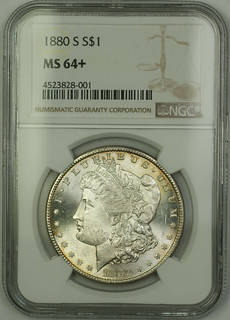 "The term
"The termslab
has never really worked for me & many others I know. Unfortunately it has been in usage pretty much since the beginning of certified coins, for well over three decades. It seems fairly insulting that the reason for its usage is the fact that it's vaguely in the shape of a coffin. Let's put our collective (pun intended) heads together & start the conversation with suggestions to change this & have the word redacted from the numismatic language. It will not happen overnight but in time we can make it happen. Calling on all for ideas."
Well, the word "slab" is short, catchy and as Tom noted, very well established in the hobby. "Encapsulated coin" doesn't really roll off the tongue, and more than just coins get the encapsulation treatment. "Capsule"? How about "Cert", short for "certified". That's short and could be catchy in time. What do readers think? -Editor
Other topics this week include the Pig Rupee and Bronzed Copper. -Editor
COIN FOUND IN LEE STATUE TIME CAPSULE
Arthur Shippee and Ron Guth passed along stories about the time capsule found in the pedestal of the Robert E. Lee statue. Thanks. "A silver coin" is mentioned, but I haven't seen any details about it. -Editor
A rust-colored 1875 almanac, a cloth envelope and a silver coin were found Wednesday in a time capsule that lay hidden beneath a towering statue of Confederate Gen. Robert E. Lee in Virginia for more than 130 years.
As intriguing as the water-damaged items were, they're not what many were expecting to see after state conservators spent five hours gingerly prying the time capsule open. Even the mortar-encrusted lead box was a bit of a surprise.
Historical records led many to believe the capsule held dozens of objects related to the Confederacy as well as a picture of deceased President Abraham Lincoln. But in just a few minutes, its contents were revealed and the items were few.

VOCABULARY TERM: BUFFING AND POLISHING
Here's another entry from Dick Johnson's Encyclopedia of Coin and Medal Terminology. -Editor
Buffing and Polishing. Treating a metal surface, often to give it a smooth and reflective finish, by use of cloth or wire buffing wheels and a polishing compound. Buffing is intended to remove minor surface striations and tool marks, polishing to add color, brightness and luster. Some polishing work can be done by hand, most however is with a motorized wheel, of two or more speeds.

LEE F. HEWITT (1911-1987)
American Numismatic Biographies author Pete Smith submitted this article on Lee Hewitt, founder of Numismatic Scrapbook Magazine. Thanks! I added images from a David Alexander CoinWeek piece about the Scrapbook. -Editor
Lee F. Hewitt (1911-1987)
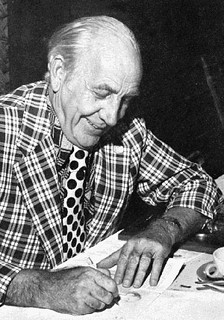 Lee Hewitt was the founder of Numismatic Scrapbook Magazine and identified with the phrase,
Lee Hewitt was the founder of Numismatic Scrapbook Magazine and identified with the phrase,There is no Santa Claus in Numismatics.
In this holiday season, here is his story.
Lee Francis Hewitt was born in Keokuk, Iowa, on January 1, 1911. His parents were a dentist, Harry Wallace Hewitt (1879-1924) and Bessie Edith Morriss Hewitt (1884-1925). His parents died when he was a young teen-ager. His 1920 Census listing was under the name of Francis Hewitt suggesting that may be what he was called as a child. His father's obituary lists survivors as including Clifford and Francis, again an indication that he was known by that name.
REMEMBERING ROBERT LLOYD
Bill Groom writes:
"I just spotted the E-Sylum piece on Mr. Lloyd. Some years ago now, I wrote an article for the Buffalo Numismatic Association about meeting him. Impressed with his persona, his gracious and generous demeanor, I was truly humbled in his presence."
Thank you! Here's the article. -Editor

LEONOR MOLINA (1869-1957)
Julia Casey submitted this article on Leonor Molina, the model for the Cuba Peso coins of 1897 and 1898. Thanks! -Editor
I came across an obituary notice from the January 15, 1957, Miami Herald for Leonor Molina who was
noted to be the model for the Cuba Peso coins of 1897 and 1898. The obituary states that she was the
winner of abeauty contest held in Camaguey, Cuba
but that she returned to New York, her home for
most of her life. I did find an 11-year-old Leonor in the 1880 New York City census living with her
family, including her mother Elvira Molina and grandmother Ynes Betancourt, all listed as born in Cuba.
There are newspaper notices in 1897 reporting on Leonor being the model for the coins.
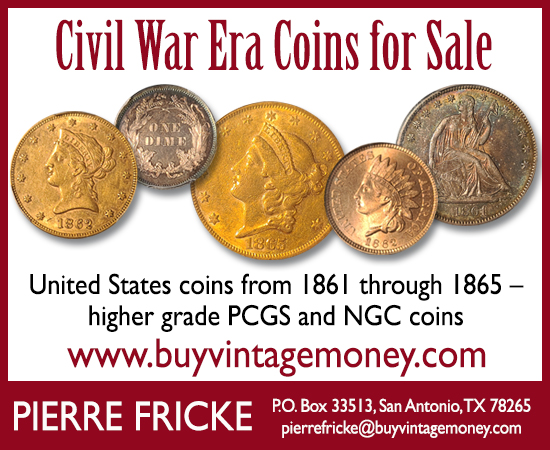
THE FUTURE OF LIVE AUCTIONS
Jeff Garrett published a great article on his NGC blog about the future of live auctions. Here's an excerpt - see the complete article online. -Editor
 Nearly every company with a substantial web presence has been experiencing a massive increase in business, including rare coin auction companies. Billions of dollars trade hands each year through online auctions, and for the first time, most of it is online only.
Nearly every company with a substantial web presence has been experiencing a massive increase in business, including rare coin auction companies. Billions of dollars trade hands each year through online auctions, and for the first time, most of it is online only.
One of my favorite numismatic stories of the distant past is about the legendary collector John J. Pittman. In the 1950s, he desperately wanted to purchase an example of the extremely rare 1854 Type-2 Gold Dollar Proof being sold at auction. When the coin came up for sale, he famously stood facing the audience with his hand raised in the air like the Statue of Liberty. This intimidating tactic worked, and he purchased the coin. The coin stayed in his collection for his entire life and was sold after his death. I later had the privilege of selling this coin to the legendary collector Del Loy Hanson.
If the coin were to be sold today, John J. Pittman would probably be facing an empty room. His scare tactic would not work, as most important buyers are now bidding from the comfort of their home or office.
HERITAGE 2022 FUN SALE PAPER MONEY HIGHLIGHTS
This Heritage press release highlights a number of U.S. paper money rarities in the firm's upcoming january 2022 FUN sales. Great notes! -Editor
One of just four examples of a rare 1882 Gold Certificate, only two of which are available to the public, could bring $500,000 or more when it crosses the block in Heritage Auctions' FUN Currency Signature® Auction - Orlando FUN January 5-7.
THE BOOK BAZARRE
AUTHORS AND PUBLISHERS: Are your books carried by Wizard Coin Supply? If not, contact us via www.WizardCoinSupply.com with details.WEXFORD EBAY MEDAL SELECTIONS DECEMBER 2021
Rich Jewell's Wexford Rare Coins and Medals eBay store features a number of great medals along with other numismatic items. Here are some that caught my eye this week. -Editor
LISTING IS FOR A 1895- ADOLPHE RIVET,SC., JOAN OF ARC, SMALL PLAQUE, CAST IN BRONZE, 113MM. REVERSE HAS TWO MOUNTING PINS(?) COULD HAVE BEEN MOUNTED IN A FRAME OR A WALL MOUNTING OF SOME KIND. IT IS A VERY NICE CASTING BY FAMED FRENCH ARTIST RIVET
OBVERSE- BUST OF JOAN OF ARC FACING RIGHT; SHE IS WEARING HER BATTLE ARMOR, A SINGLE LARGE FLEUR DE LIS TO THE RIGHT, SIGNED BY THE ARTIST BEHIND THE BUST
REVERSE- AS DESCRIBED ABOVE & UNIFACE
FORRER, VOL. V, PP.135-137
Beautiful Joan of Arc display piece. -Editor
To read the complete lot description, see:
1895-Adolphe Rivet, Sc., Joan of Arc, small plaque, cast in bronze,113mm
(https://www.ebay.com/itm/194492825295)

NUMISMATIC NUGGETS: DECEMBER 26, 2021
Here's a selection of interesting or unusual items I came across in the marketplace this week. Tell us what you think of some of these. -Editor
Mansfeld 1593, Taler, 28.56g. VF/EF. Line of Friedeburgs (Peter-Ernst I, Bruno II, Gebhard VIII, and Johann-Georg IV). Obv: Coat of arms. Rev: Saint George on horse right, slaying dragon.
Donated by Harlan J. Berk, Ltd.
A nice Saint George and the Dragon piece. From the American Numismatic Society 2022 Gala sale. -Editor
To read the complete lot description, see:
Mansfeld taler 1593
(http://numismatics.org/2022-gala-auction-preview/)
Other topics this week include Trade Tokens issued in the seventeenth century, a counterstamped Shield Nickel, the 2019 American Liberty High Relief Silver Medal, and an East Caribbean States banknote. -Editor

SOURCES OF ROMAN SILVER COINAGE
A new study examines the origin of silver used in Roman coinage from the Iberian Peninsula. -Editor
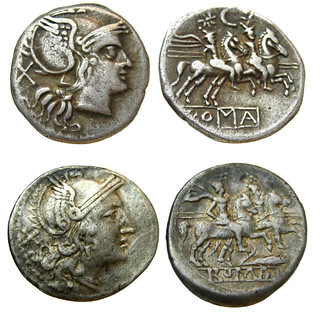 Despite its prior status as a luxury commodity, silver became widely used for coinage in the Roman world from the 7th century BCE onward and provided a standardized monetary system for ancient Mediterranean civilizations. However, the sources of silver used to produce Roman coinage have largely been used up, making it difficult to determine which deposits Roman miners exploited.
Despite its prior status as a luxury commodity, silver became widely used for coinage in the Roman world from the 7th century BCE onward and provided a standardized monetary system for ancient Mediterranean civilizations. However, the sources of silver used to produce Roman coinage have largely been used up, making it difficult to determine which deposits Roman miners exploited.
A new study published in the journal Geology yesterday evaluated silver sources from different mining provinces in the Iberian Peninsula to determine which locations may have been mined for silver to produce Roman coinage.

THE COINS OF CHRIST
Stack's Bowers World and Ancient Coins Numismatist Nicholas Fritz published a blog article on the coins of Christ. -Editor
"Behold, you will conceive and give birth to a son, and you are to give Him the name Jesus." The words recorded in the Gospel of Luke 1:31 that herald the birth of Jesus form part of the famous nativity story often repeated at this time of year. The life of Jesus, a humble carpenter's son from Judea, has indelibly and inextricably changed the course of human history. It is easy to forget that he lived as a normal inhabitant of Judea, and this normalcy extended to his use of money, and the lessons he learned from interacting with it.
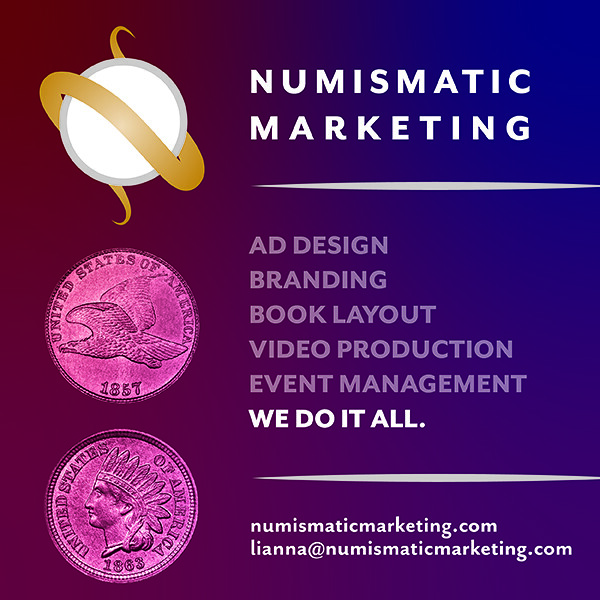
JERSEY COIN HOARD SOLD
The world's largest ever hoard of Iron Age coins has been bought by the island of Jersey. -Editor
The world's largest ever hoard of Iron Age coins has been bought from the Queen by the island of Jersey for £4 million using funds retrieved from criminals.
ISRAELI ARCHAEOLOGISTS EXPLORE SHIPWRECK SITE
Arthur Shippee passed along this Washington Post article about a recent shipwreck find off the coast of Israel. Thanks. -Editor
Hundreds of rare antiquities were discovered off the Mediterranean coast of Israel, archaeologists there said Wednesday.
The Israel Antiquities Authority said the artifacts were found in recent months as its Marine Archaeology Unit explored the remains of two ships that sank roughly 1,700 and 600 years ago off the coast of Caesarea. The shipwreck remains were found scattered on the sea floor in shallow water.

PLATFORM TICKETS
Earlier this month Yosef Sa'ar forwarded these images and asked, "Have you ever heard of platform tokens?" I hadn't, and he kindly provided some additional information per Wikipedia. -Editor
A platform ticket is a type of rail ticket issued by some railway systems, permitting the bearer to access the platforms of a railway station, but not to board and use any train services. It allows people to walk with their friends, associates and loved ones all the way to the passenger car at stations where the general public is not admitted to platforms. Trainspotters can also purchase platform tickets and enjoy their trainspotting hobbies.[1] They vary in type: some may only allow limited access and a sharply limited time of usage, while others may have totally free access to enter the platform area. During peak usage hours or rush hours, the platforms may only be available for passengers who intend to travel.

LEALANA BITCOIN SET OFFERED
Stacks Bowers Director of Consignments and Numismatics James McCartney published a blog article about the firm's upcoming sale of a set of silver 2013 Lealana physical bitcoins. -Editor
We are excited to feature a scarce four-coin set of silver 2013 Lealana physical bitcoins in our Spring 2022 Showcase Auction. Struck in .999 fine silver and graded by PCGS, this set offers incredible rarity and exceptional condition. Each coin is marked with the serial number 24, making it one of the earliest sets issued by Lealana creator Noah Luis, aka "smoothie."
THE BOOK BAZARRE
SEVENTY-FIVE YEARS OF RED BOOK HISTORY come to life in Kenneth Bressett's A Penny Saved: R.S. Yeoman and His Remarkable Red Book—a combined history of Western Publishing and the Red Book, biography of Yeoman, and memoirs of Bressett himself. 352 pages, hardcover, richly illustrated. Order your copy online at Whitman.com , or call 1-800-546-2995.JUDAICA ART MEDAL AWARDS ANNOUNCED
Two medalists received the Mel Wacks Judaica Art Medal Award at the Tokyo FIDEM. Here's the press release. -Editor
Mel Wacks Judaica Art Medal Award Announced at FIDEM Tokyo 2020/2021
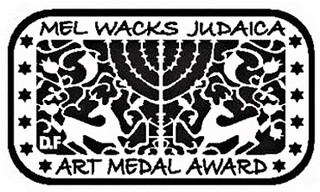 At FIDEM Tokyo 2020/2021, the biennial Congress of the International Art Medal Federation, two medalists were chosen to share the Mel Wacks Judaica Art Medal Award, for Judaic, Biblical or Holy Land themes - Ewa Olszewska-Borys of Poland and Romualdas Incirauskas of Lithuania. Each will receive an engraved silver medal, courtesy of the Jewish-American Hall of Fame, and will share the $250 prize money, presented by the Cincinnati Skirball Museum, home of the Jewish-American Hall of Fame Medal Collection. Wacks founded the Jewish-American Hall of Fame in 1969, and has served as its director since then.
At FIDEM Tokyo 2020/2021, the biennial Congress of the International Art Medal Federation, two medalists were chosen to share the Mel Wacks Judaica Art Medal Award, for Judaic, Biblical or Holy Land themes - Ewa Olszewska-Borys of Poland and Romualdas Incirauskas of Lithuania. Each will receive an engraved silver medal, courtesy of the Jewish-American Hall of Fame, and will share the $250 prize money, presented by the Cincinnati Skirball Museum, home of the Jewish-American Hall of Fame Medal Collection. Wacks founded the Jewish-American Hall of Fame in 1969, and has served as its director since then.
WEYBURN SECURITY BANK NOTES
George Manz submitted this article about banknotes of the Weyburn Security Bank to be displayed at the 2022 Spring Regina Coin Show. Thank you. -Editor
The Weyburn Security Bank and its Rare Banknotes
By George Manz, FRCNA
In the early 1880s, the Canadian Pacific Railway began to bring settlers into southern Saskatchewan to farm the prairie landscape. The village of Weyburn was founded in 1899.
The Weyburn Security Company was formed in Weyburn in 1902 by a small group of American settlers from South Dakota and Minnesota. They purchased 50,000 acres of land with the aim to settle southeastern Saskatchewan.
They soon realized for their real estate, private banking, insurance, and lumber business to succeed, they needed to set up a chartered bank. So, in 1910, they petitioned the Canadian Parliament for a charter to incorporate as The Weyburn Security Bank.
THE IMPORTANCE OF NUMISMATICS
Earlier this month Samuel Vargas Rodríguez published a nicely illustrated article on the Tauler Fau blog about the Importance of Numismatics. -Editor
Numismatics is the science studying the coins and the objects connected with them. It is an auxiliary branch of archaeology. In fact, in the academic world numismatics and epigraphy – the discipline decoding the inscriptions found on a solid base, such as the metal and stone in tombstones and monuments, – are often part of the same subject. As a result, numismatics is a supporting science, which is essential to get to know and complement effectively the archaeological studies, or the history of ancient civilizations. Thanks to the coins and other objects, it is possible to determine the age of the archaeological sites with little margin of error.

WHICH CAME FIRST: DEBT OR MONEY?
A Coin Update article by Dennis Tucker discusses references to coinage in a book about cities. Here's an excerpt - see the complete article online. Which Came First: Debt or Money? -Editor
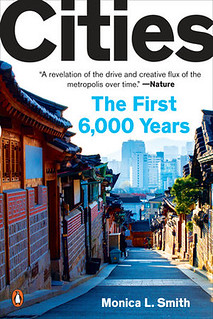 The other day I was reading Monica L. Smith's Cities: The First 6,000 Years. Dr. Smith is a professor in the Department of Anthropology at UCLA, and director of the South Asian Archaeology Laboratory at the university's Cotsen Institute of Archaeology. Her book is, as Science magazine puts it,
The other day I was reading Monica L. Smith's Cities: The First 6,000 Years. Dr. Smith is a professor in the Department of Anthropology at UCLA, and director of the South Asian Archaeology Laboratory at the university's Cotsen Institute of Archaeology. Her book is, as Science magazine puts it,a compelling journey from city life in ancient urban centers to the present and beyond.
In a section titledWhere Did All the Money Go?
Smith delves into the history of economics.We might think that coinage came first and that abstract debt instruments such as bills of lading and credits cards and bank loans came later,
she writes.But it's actually the reverse, because the idea of debt and repayment was in existence long before the development of coined money.
Reciprocity, at first sealed with words and a handshake, later was put down in writing and then in durable physical symbols of value, such as coins and paper currency.

NEW BOOK: THE PRIVATE LIBRARY
To a bibliophile, life wouldn't be quite worth living without books. This New York Times article mentions a new book on the history of the private library. Here's an excerpt - see the complete article online. -Editor
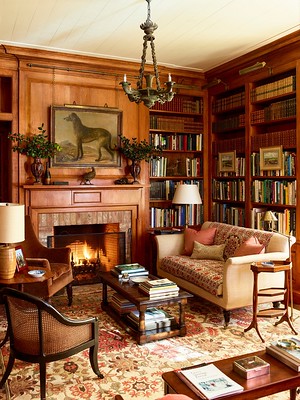 At the turn of the millennium, Reid Byers, a computer systems architect, set out to build a private library at his home in Princeton, N.J. Finding few books on library architecture that were not centuries old and in a dead or mildewed language, he took the advice of a neighbor across the street, the novelist Toni Morrison.
At the turn of the millennium, Reid Byers, a computer systems architect, set out to build a private library at his home in Princeton, N.J. Finding few books on library architecture that were not centuries old and in a dead or mildewed language, he took the advice of a neighbor across the street, the novelist Toni Morrison.
Ms. Morrisononce famously said if there is a book you want to read and it doesn't exist, then you must write it,
recalled Mr. Byers, 74, in a video chat from his current home, in Portland, Maine.
The project stretched over a generation and culminated this year in a profusely illustrated, detail-crammed, Latin-strewn and yet remarkably unstuffy book calledThe Private Library: The History of the Architecture and Furnishing of the Domestic Bookroom,
published by Oak Knoll Press.
LOOSE CHANGE: DECEMBER 26, 2021
Here are some additional items in the media this week that may be of interest. -Editor
John and Nancy Wilson passed along this New-York Historical Society article about the New York City Origins of Santa Claus. Thanks. -Editor
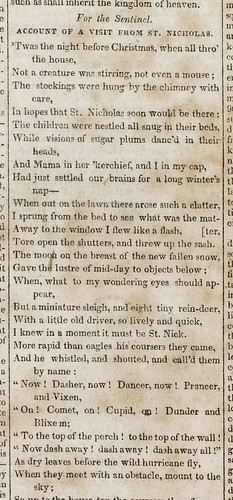 Anyone who knows about Jolly Old St. Nick will tell you that he and Mrs. Claus's lifelong home is at the North Pole…and we're here to tell you otherwise! Sorry, friends. The Santa you know and love today is actually from New York City! Or at least the image of Santa that has become commonplace today was invented by a few prominent 19th-century New Yorkers: Clement Clarke Moore, Washington Irving, and Thomas Nast.
Anyone who knows about Jolly Old St. Nick will tell you that he and Mrs. Claus's lifelong home is at the North Pole…and we're here to tell you otherwise! Sorry, friends. The Santa you know and love today is actually from New York City! Or at least the image of Santa that has become commonplace today was invented by a few prominent 19th-century New Yorkers: Clement Clarke Moore, Washington Irving, and Thomas Nast.
Of course, some notion of Santa existed before the 19th century. Our Christmas elf is based on the real historical figure of St. Nicholas of Myra (or Bari), a man who died on December 6, 343 CE, in modern day Turkey. He was said to have performed many good deeds and miracles in his life. One good deed was secretly giving bags of gold to a family whose three daughters needed dowries to be saved from a life of poverty, and one miracle was a ghastly tale of Nicholas resurrecting three murdered children. Therein lie the origins of associating St. Nick with gift giving and kindness to kids.
Today, Nicholas is revered in the Catholic faith as the patron saint—kind of like a protector—of sailors, merchants, archers, repentant thieves, children, brewers, pawnbrokers, and students. St. Nick is particularly celebrated in the Netherlands, where a holiday called Sinterklaas happens annually on December 5 or 6. Worldwide, many Catholics celebrate St. Nick's Feast Day on December 6—the day he died.
The Dutch brought their devotion to St. Nicholas with them to the places they colonized, including New Amsterdam. New Yorkers of Dutch and other heritages grew up in the late 17th and early 18th centuries celebrating some form of Sinterklaas, or seeing others do so. Many revolutionary-minded New Yorkers developed an interest in Dutch culture because of a distaste for the British after the U.S. gained its independence.
To read the complete article, see:
The New York City Origins of Santa Claus
(https://historydetectives.nyhistory.org/2018/12/the-new-york-city-origins-of-santa-claus/)
Other topics this week include the Rust Rare Coin Ponzi scheme, and Chinese Banknote Printing Mischief. -Editor
FEATURED WEB SITE: BUFFALO NUMISMATIC ASSOCIATION
This week's Featured Web Site is the Buffalo Numismatic Association.
Since 1927, The Buffalo Numismatic Association (The BNA) has been dedicated to promoting the hobby of coin and money collecting. Membership is open to anybody that is interested in promoting, learning or supporting the hobby of numismatics. The club encourages fellowship among member collectors and dealers. The BNA holds monthly meetings, monthly coin shows, a fall convention and a major spring coin show where dealers, members and the public can buy, sell and trade coins, bills, tokens and related numismatic items.
The Buffalo Numismatic Association is a non-profit organization that is also is dedicated to serving the community of Western New York. Through partnerships with other area coin clubs, The BNA has supported various numismatic related activities and partnered with the local Boy Scouts and Girl Scouts to host Coin Collecting Merit Badge Workshops.

